Set Up the Ideal Ball Position to Flush Driver
Are You Using the Wrong Ball Position for Driver? Find Out How to Fix Your Setup and Hit It Flush Every Time.
If you’re dying to get more distance off the tee, your first step should be perfecting your ball position for driver.
This may seem like such a small detail in your golf game, but your ball position at address affects everything. The right position helps you nail the ball at the right angle of attack with the right club face orientation and the right aim. More to the point, the right ball position helps you hit it flush every time.
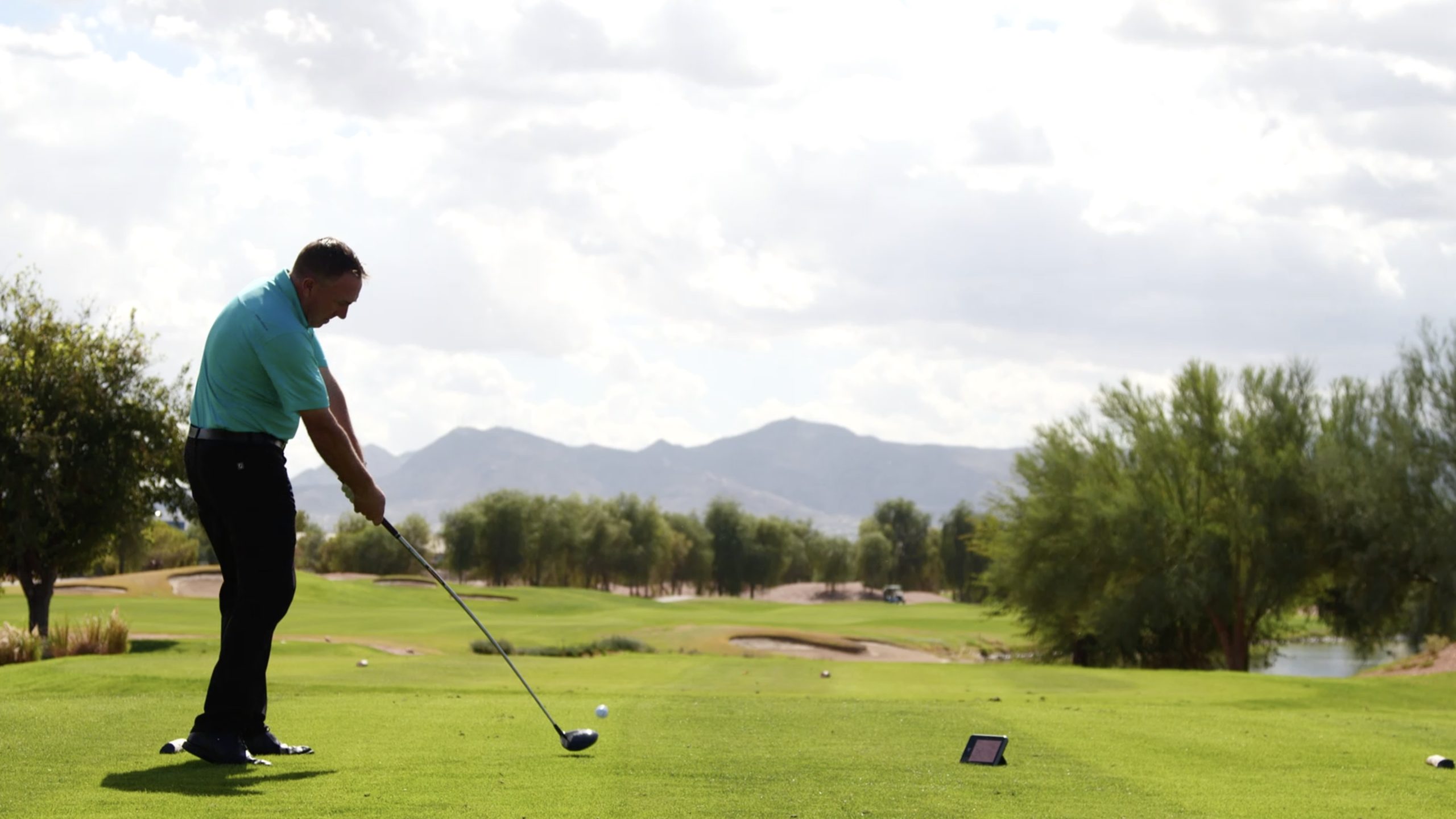
The wrong golf ball position . . .
. . . well, let’s just say it’s a recipe for disaster.
If you’re struggling to hit longer drives, you’ve come to the right place. Before you start dissecting your golf swing, take a look at where your ball is. I’m about to show you:
- How to reference ball position. (It’s not all about the feet!)
- Telltale signs that your ball position is off.
- A step-by-step process for finding the correct ball position for drivers.
- My favorite drill for powerful shots with your driver.
But first, I’m going to explain why ball position is the place to start when you want to hit longer drives.
Importance of Ball Position for Driver
If you’ve been golfing for any length of time, you understand how golf clubs work. You know each club serves a dedicated purpose and comes with different instructions.
Your driver is unique compared to every other club in your bag. And yet, the most common driver mistakes come from using this club the same way you’d use any of the others.
When you use your driver, your golf swing should be slightly different from what it would be with an iron. The guidelines for proper golf posture change slightly for a driver. And—as we’re about to discuss here—you need a different ball position for drivers.
The Fundamental Difference of Hitting Drivers vs. Irons
There is one key difference between a successful iron shot and a successful drive.
- When you hit your irons, you want to hit down on the ball.
- When you hit your driver, you want to hit up on the ball for a farther result.
By “hitting up on the ball,” I mean you want to make contact slightly after the low point of your golf swing, when the club head is traveling upward.
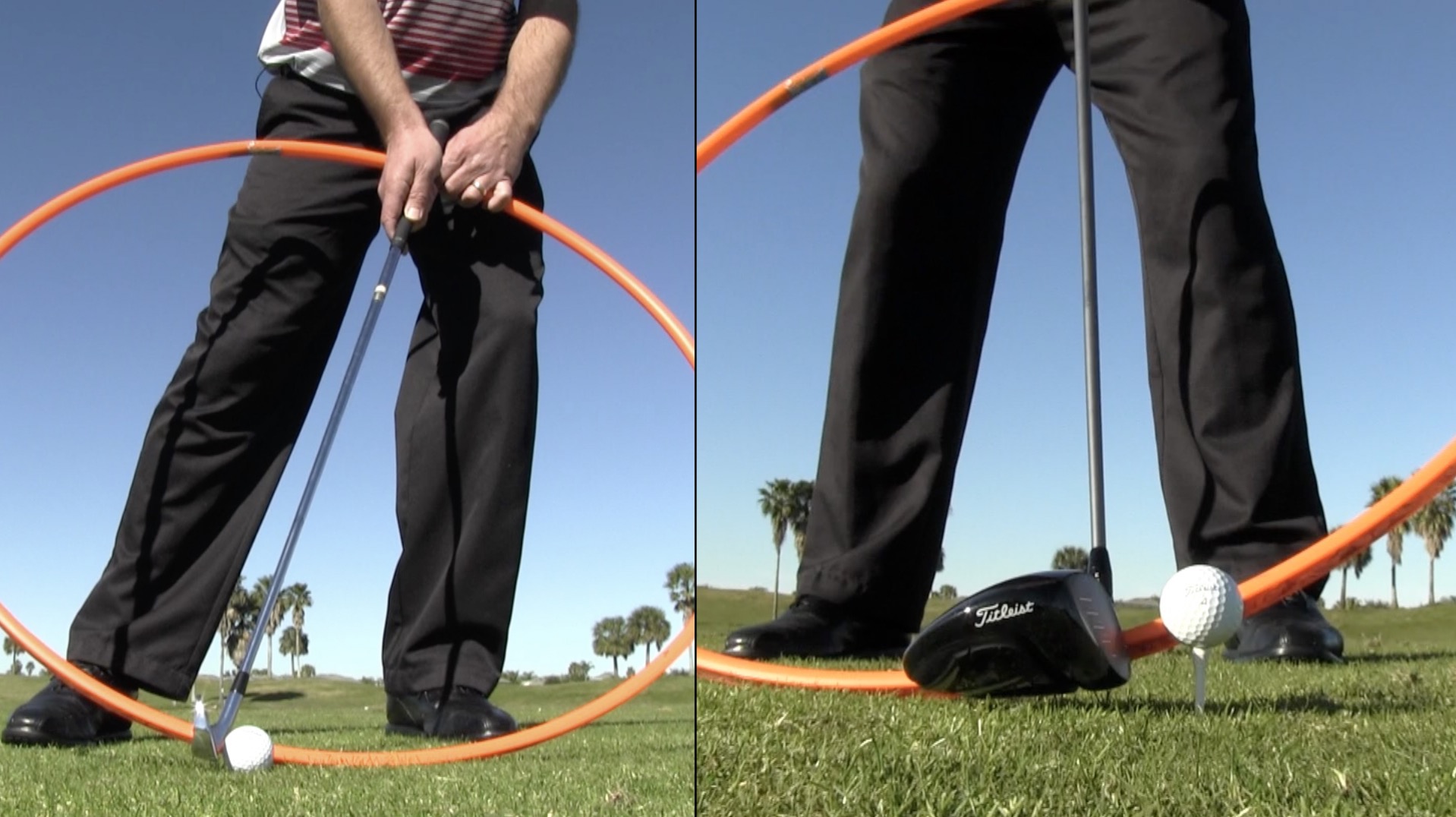
Hitting up on your driver is fundamental to making those long, satisfying golf shots. If you watch the longest drivers in the world, you’ll see that they’re consistently hitting up every single time.
Now, I will admit there are some professional golfers who hit down on their drivers. This is incredibly rare, and they only get away with it because they have astounding club head speed.
You probably cannot get the same results, even if you can generate serious speed in your swing. If you’re routinely hitting down on your driver, you need to learn to hit up.
There are several things you can do to ensure a positive angle of attack. But the easiest adjustment—an adjustment you can make immediately—is to learn the correct ball position for drivers.
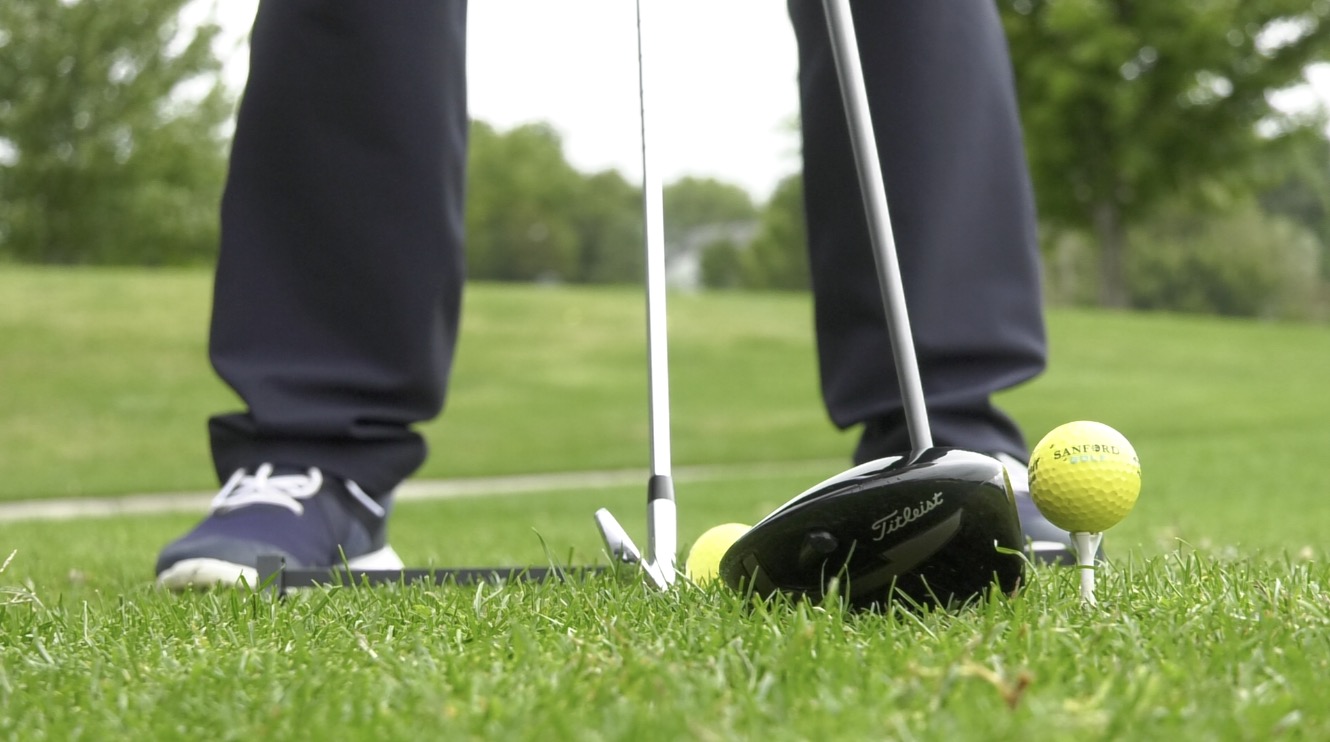
What Happens if You Have the Wrong Ball Position for Driver?
I’ll be the first to admit that a lot of things can go wrong in a golf swing.
Improper golf grip. Weak transition. Incorrect swing path. Poor body rotation. The list goes on and on.
So, how are you supposed to know that the problem is an incorrect golf ball position for drivers? Sure, you know that ball position can be the cause for a nasty habit of hitting down, but even that is hard to feel in your own swing.
Start by looking at the results of your drive. Here are a couple signs that you could have a problem with ball position for drivers.
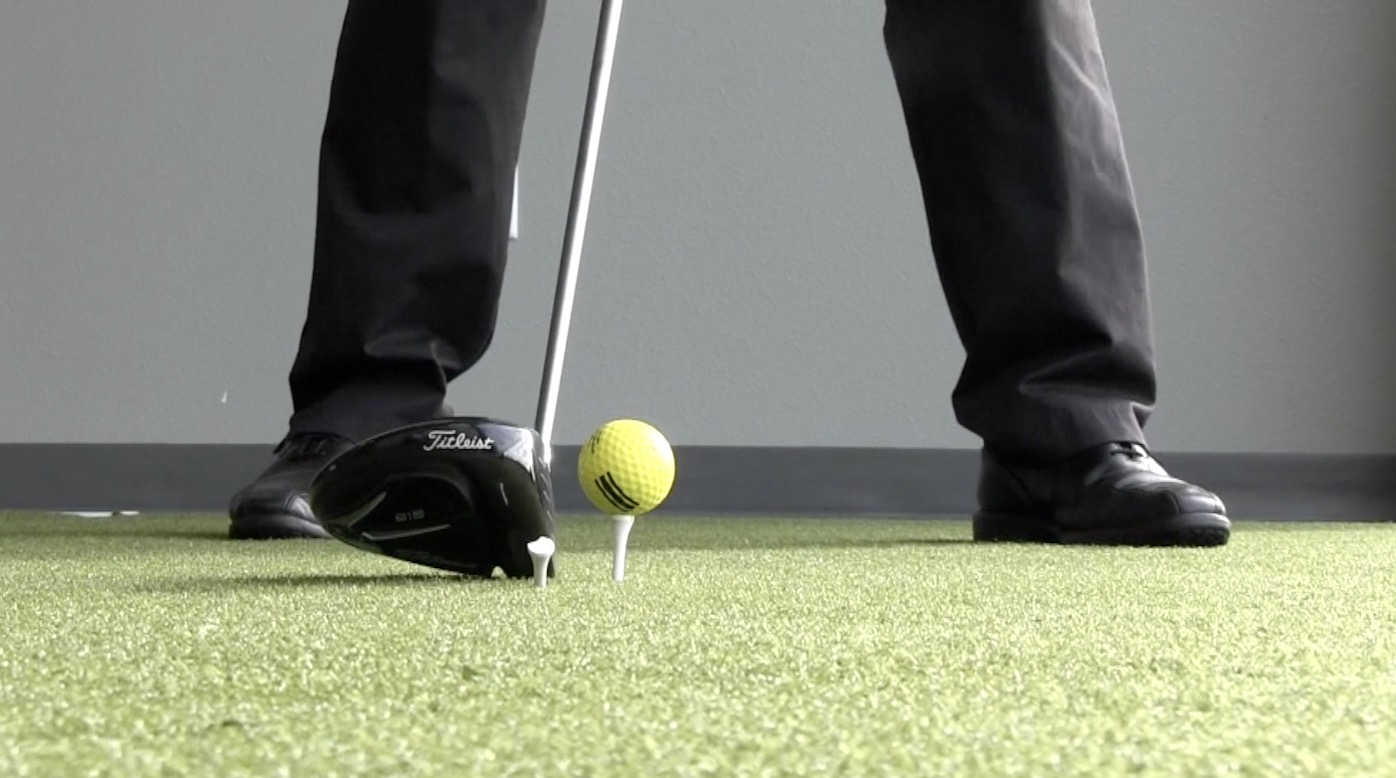
Excessive Spin
If there is way too much spin on your golf ball, you probably haven’t mastered ball position.
You can recognize excessive spin by the nature of your ball flight. If the golf ball reaches its peak height then immediately falls to the ground and doesn’t roll . . . you have too much spin.
Excessive spin is a major distance killer and a great reason to adjust your ball position for drivers.
Poor Contact
Where does your golf ball usually make contact with your club face? Does it tend to hit solid in the center? Or do you have problems hitting the ball off the toe or the heel? Maybe you hit it too high or too low on the face.
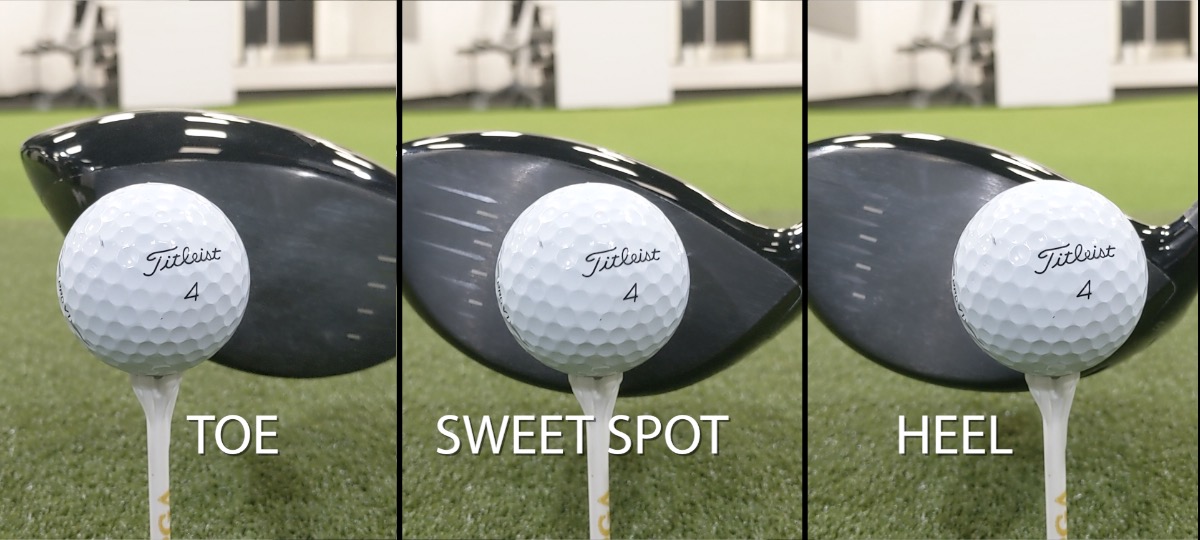
Whatever the issue, you’ll know you’re not getting a flush hit when the ball flies off course.
Poor contact is a painful struggle for a lot of golfers. If this is a common problem for you, you know the suffering. You work hard to maximize swing speed, only to hit the world’s most powerful shank.
Distance means nothing if you send the golf ball yards upon yards in the wrong direction. Fortunately, you may be able to fix it just by moving your ball position.
Fix Golf Ball Position Before Anything Else
All the golf miseries listed above often indicate incorrect ball position.
But do they definitely, absolutely only happen when your golf ball is in the wrong spot?
Of course not. These issues could point to other problems in your golf setup or swing motion.
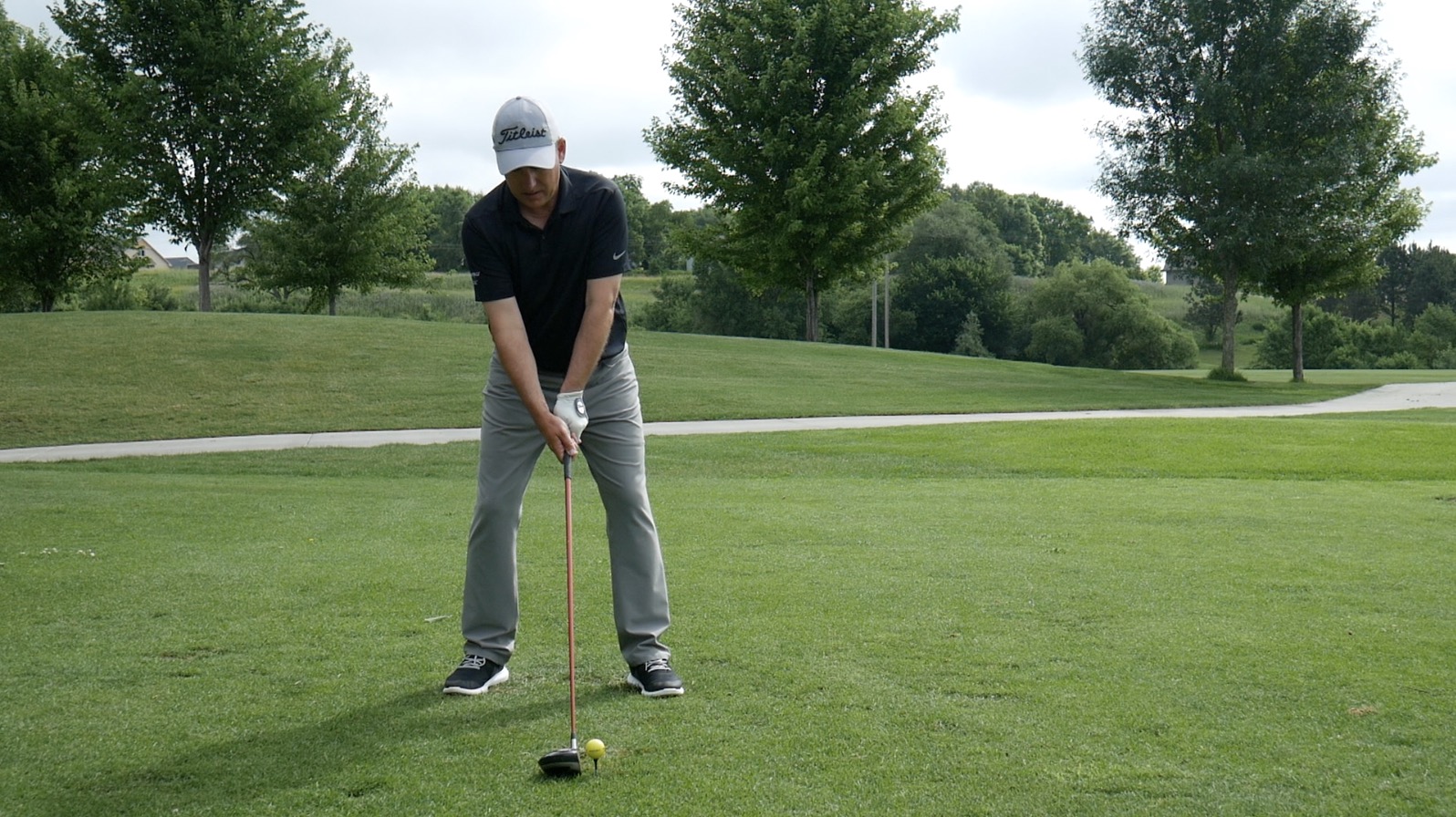
Nevertheless, golf ball position is the easiest, fastest adjustment to make. So, I recommend starting there. Follow the steps I’m about to share to ensure the ideal ball position for drivers. Get the right position every time you step up to the tee, and see if you get better drives.
If you do, congratulations! You’ve just put in 30 seconds of work to vastly improve your golf game.
How to Determine the Correct Ball Position for Your Driver
Ball position isn’t what you think. Or, more accurately, it isn’t only what you think.
When most people refer to golf ball position, they’re talking about where the ball is in relation to your feet. To phrase it another way, they’re referring to where the ball sits within your golf stance.
They’re not wrong to talk about ball position this way. Stance is an important aspect of your golf setup.
However, if you really want to improve your golf skills, you have to think about the entire shape of your golf posture. Where is your golf ball in relation to your feet? What about in relation to your head and body? How do the club shaft and golf ball relate to one another?
As I break down the proper golf ball position for drivers, I’m going to talk about the following three reference points.
Where is the Golf Ball in Relation to Your Feet?
When we talk about ball position in relation to your stance, we define the position one of three ways.
The ball might be forward in your stance, meaning that the ball is closer to your lead foot than to your trail foot.
Or, we might say the ball is farther back in your stance, which indicates that the golf ball is closer to your trail foot.
And finally, the ball might be centered in your stance. As you likely guessed, this means the distance between the ball and your lead foot is equal to the distance between the ball and your trail foot.
Where is the Golf Ball in Relation to Your Body?
By “body,” I mean your chest or torso. What part of your upper body aligns with the golf ball?
With my students, I often use reference points such as:
- The buttons or zipper on their golf shirt
- The logo on their shirt
- The inside of their arm
Where is the Golf Ball in Relation to Your Head?
For example, does the golf ball align with the eye, ear, or nose?
Where Should the Golf Ball Be?
I provide these reference points to make sure we’re on the same page and to give you a clearer understanding of how varied ball position can be.
You may already know the common rule for hitting drivers versus irons. Maybe you’re skimming this article, thinking that you already know to hit up on your driver. You’re aware that the golf ball should be more forward in your stance.
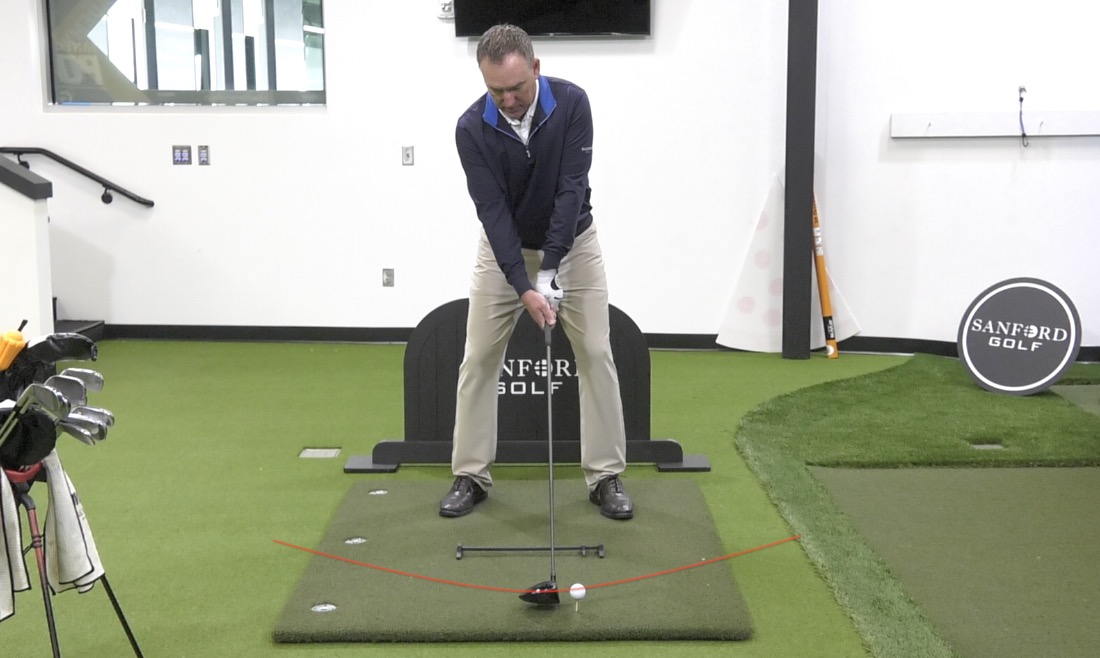
But if you’re only look at where the ball is in your stance, you haven’t learned everything you need to know about ball position for drivers.
We’ll take a closer look in just a second, but let’s address one question first.
Why Do You Want to Hit Up on Your Driver?
Let’s get a few examples here. Most amateur golfers look at PGA Tour averages for driver and immediately balk at the idea that they should hit up on the ball. After all, why would you want a higher launch angle if Tour average for angle of attack is slightly negative?
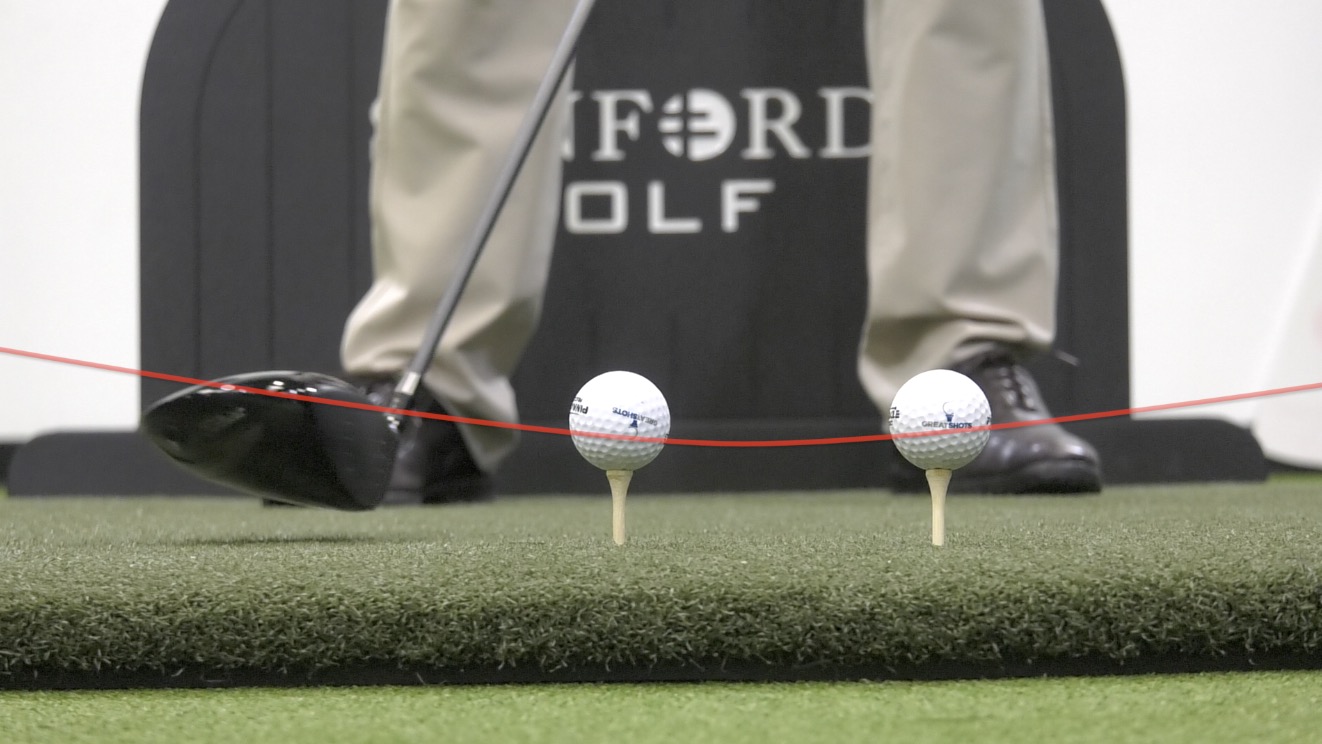
Well, there’s a few factors at play here. First, the average swing speed on Tour is around 113 mph. Do you have that type of swing speed? Probably not. Many golfers top out in the mid-90s to mid-100s. Most juniors, seniors, and female golfers don’t hit those speeds either.
The other thing is that lower ball flight tends to produce more spin. So if you have a slower swing speed already, and you hit the ball with more backspin, you will get less roll upon impact.
So let’s look at a different stat. the LPGA average swing speed is about 94 mph. Let’s use that as a better base number. What is the average angle of attack on the LPGA Tour? 3 degrees up.
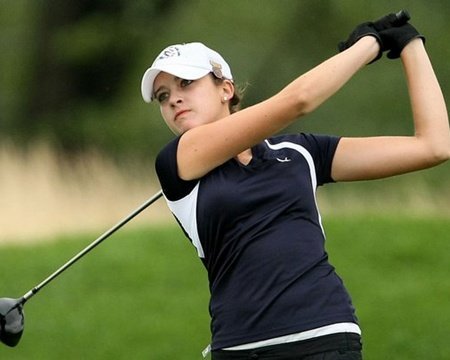
If you have ever watched an LPGA event, you will see some of the most fluid, effortless golf swings.
Without getting too scientific, just know that a higher launch angles more optimum for slower swing speeds. Now that does not mean that you want a 30 degree launch angle if you have 70 mph ball speed (extreme example, but you get the point). Force comes into play here as well, and at some point if you are not creating enough force on the ball, you need to start bringing launch angle down.
So to maximize distance the average amateur golfer, you need higher launch, which will also bring down spin rates. Less spin will also allow the ball to roll out more on impact. More roll = more distance.
How to Set Up the Ideal Ball Position for Drivers
I am going to walk you through your ball position setup step by step. Notice if anything feels different from your regular setup. That difference could explain why you keep hitting down on your driver.
Once we’ve gone over the proper ball position for drivers, I’ll share a bonus tip for hitting strong, long drives every time.

The Best Ball Position in Relation to Your Feet
In order to hit up on your driver, you want the golf ball more forward in your stance.
Now, I personally love to use the Rimer Ball Position Trainer when I work on ball position with my students. If you haven’t heard of it, it’s a super simple training aid that uses an alignment ruler and slider to mark the perfect ball position.
I find the Rimer is super helpful in training my students to visualize the perfect ball position with precision and consistency.
If you don’t have this tool, no problem. Just follow these easy steps.
- Stand with your feet together and the golf ball aligned with the crack between your feet.
- Hold your club out in front of you to check that you have a proper golf grip and your club face is square.
- Position the club head down behind the ball.
- Step your lead foot a tiny bit forward (towards the target).
- Take a much bigger step back (away from the target) with your trail foot.
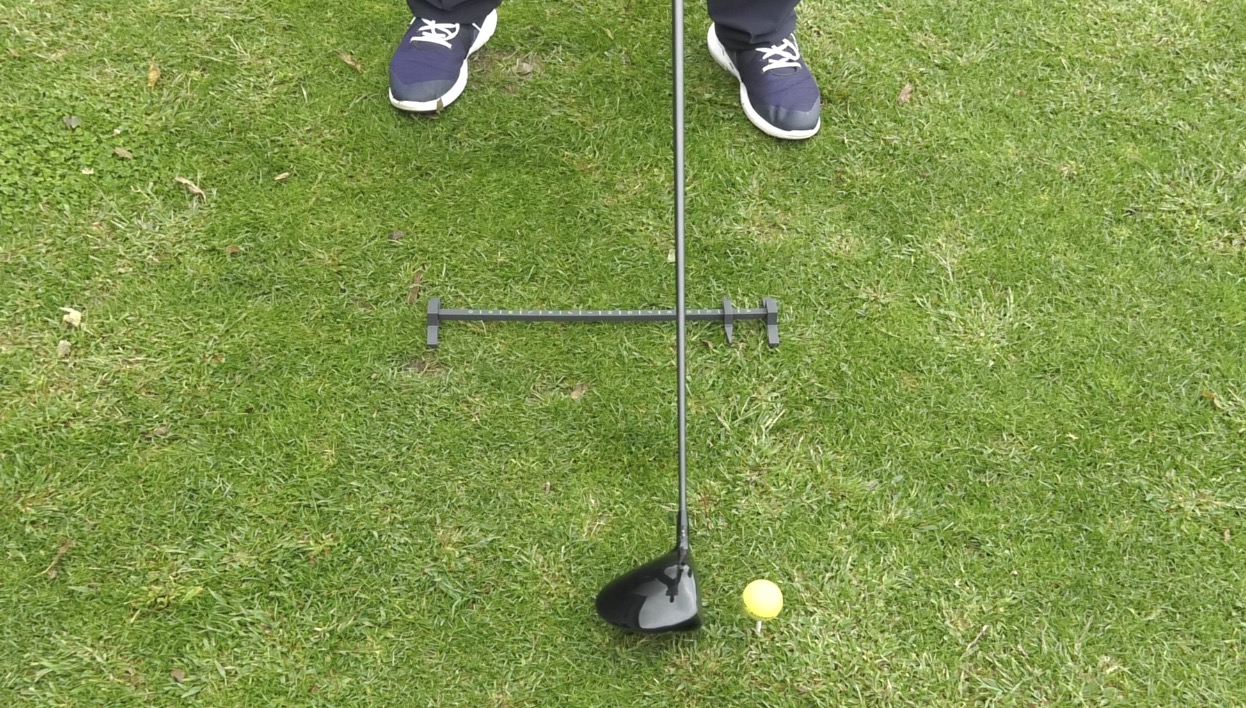
The ball should now be forward in your stance, just off the lead heel or toe (left heel for right-handed golfers). If it is, you’re ready to take a look at your upper body position.
The Best Ball Position in Relation to Your Body
Check to see that the ball is aligned with the inside of your lead arm. If it’s not, adjust your body accordingly.
When many golfers check the alignment between ball and body, they find that their golf ball is often off their zipper or buttons. This could be hindering their ability to hit up on the ball.
Make sure the ball position for driver is off the inside of your lead arm. Then move on to your head.
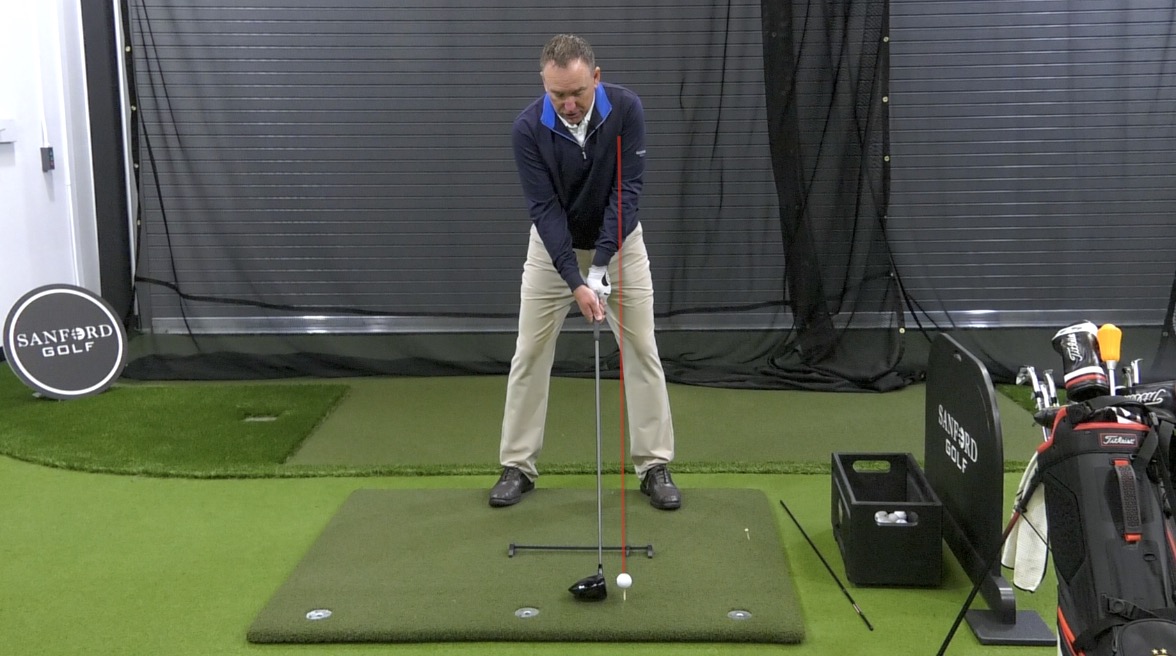
The Best Ball Position in Relation to Your Head
This one couldn’t be easier.
Tilt your head away from the target just slightly so the ball is in alignment with your lead ear.
That’s it. Now you’re golden.
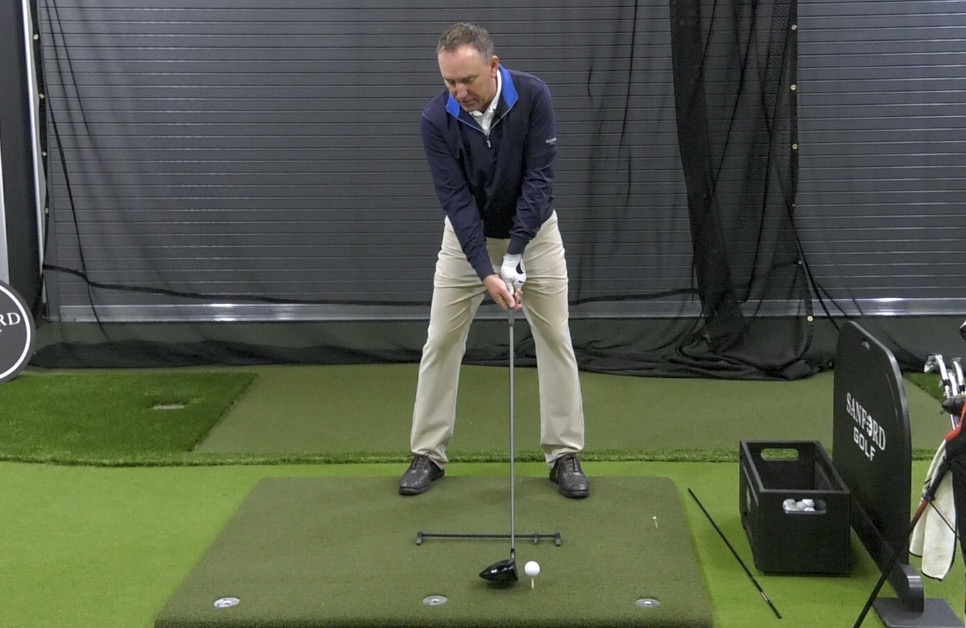
Follow these three rules for ball position for drivers, and there’s an excellent chance you’ll start making the drives you always suspected you were capable of.
Now for a bonus tip.
A Bonus Tip for Longer Drives
This is one of my favorite tips for any golfer for swinging your driver. It’s so easy, and it’s extremely effective.
- Take your driver setup with the ball position guidelines you just learned.
- Hover the golf club above the ground behind the ball, before you even start the backswing.
- Take your golf shot.
Almost seems too simple to make a difference, right? Nevertheless, hovering your driver accomplishes two pretty major things.
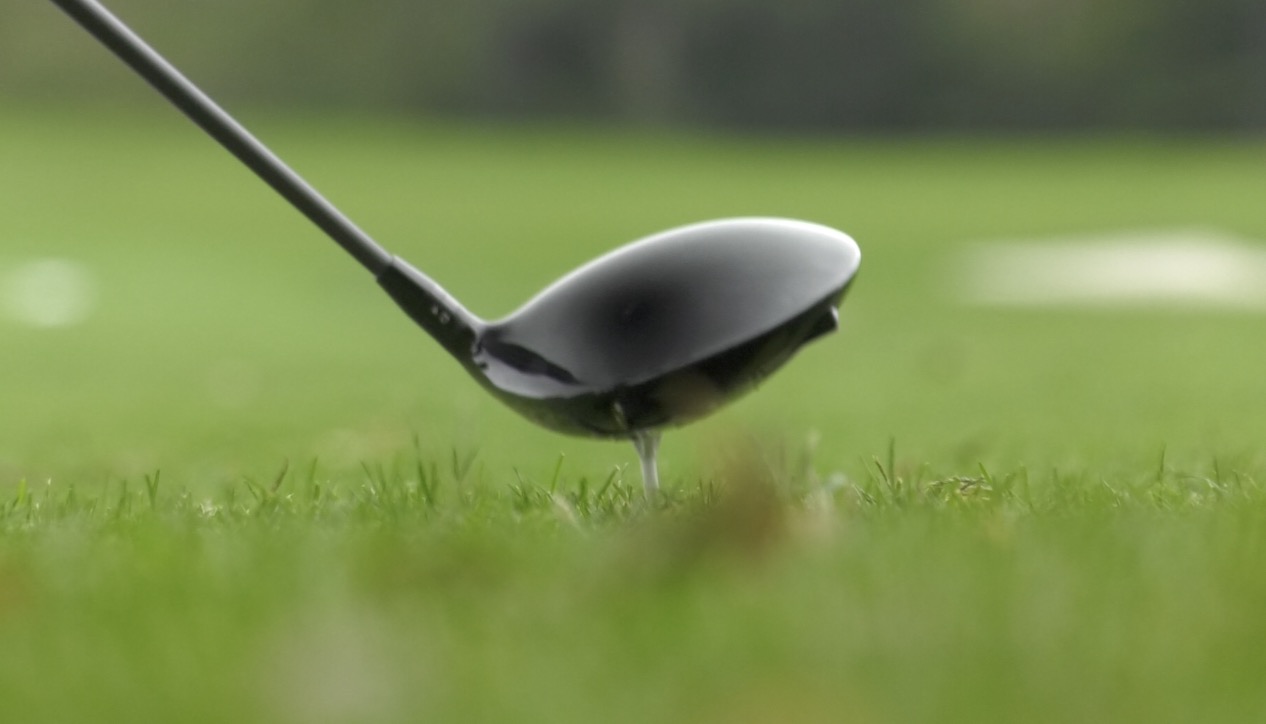
First, it prepares your body and mind to swing through the ball as it’s propped in the air instead of hitting down on it as you’re used to with your iron shots.
If you think about it, you realize that your driver is the only club that hits the ball in the air. By hovering the club head at setup, you remind your body and mind that this isn’t a regular golf shot. You are literally playing in the air.
Second, this maneuver helps you establish solid rhythm and tempo. By hovering the club, you have to bear the weight of the club from address. You’re not starting with the weight of the club on the ground and then picking it up at the takeaway.
When you bear the weight from the very beginning, you set yourself up for a smoother takeaway and a solid transition.
Next Time You’re at the Tee . . .
If you put all these ideas into practice the next time you’re at the driving range or on the course, you’re almost certain to see a difference.
Here’s a quick checklist of everything we went over. Next time you’re teeing off, remember this to get proper ball position for driver:
- Position the ball forward in your stance.
- Align the ball with the inside of your lead arm.
- Tilt your head away from the target so the golf ball is off your lead ear.
- Hover the club head behind the ball at address.
Once you’ve tried these changes, check back in and let us know if this advice worked for you. And if you want to know the correct golf ball position for irons, we’ve got you covered!
Have anything else to share? Any advice of your own or differences of opinion! Let’s discuss! Join us in the comments below.
For more in-depth golf tips, visit us at GreatGolfTipsNow.com. This golf instruction is completely free and packed with detailed advice to help you play better golf!


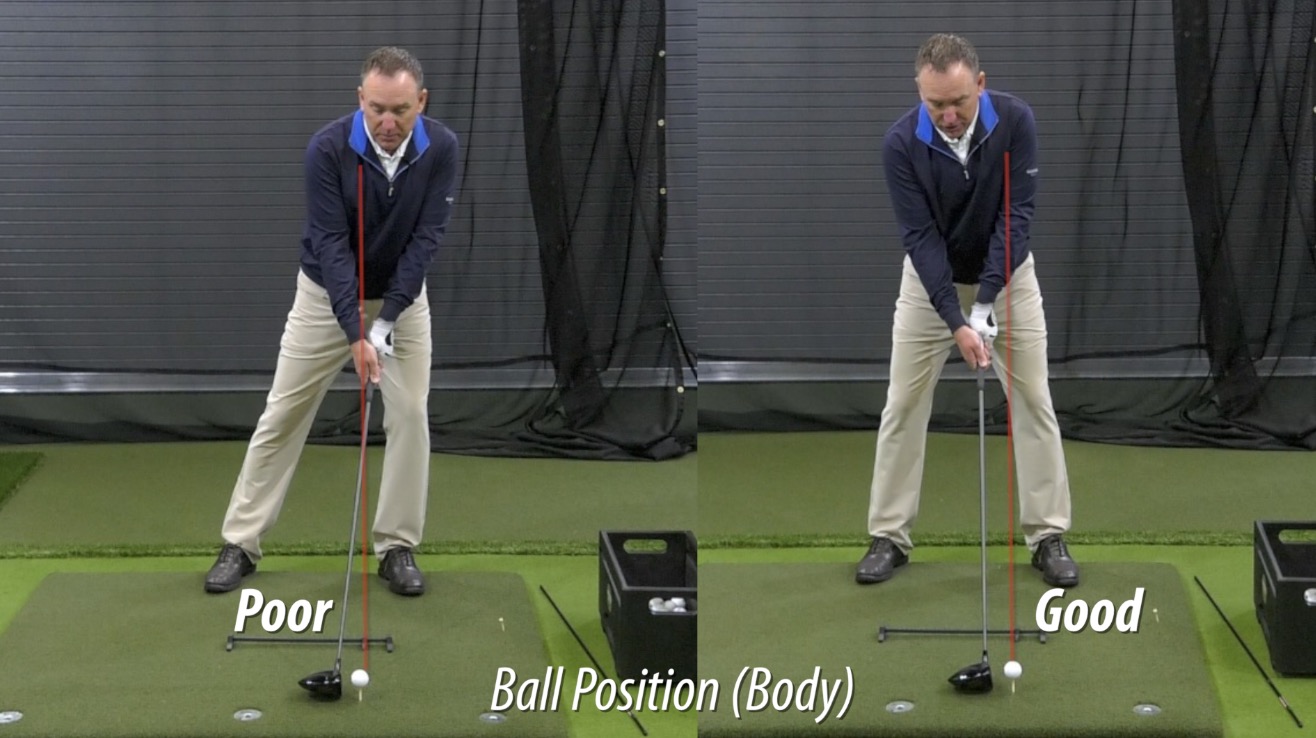
This makes sense & at my age (75) I need all the help I can get
Thats great advice. My problem is once I do the proper set up I ruin everything by swayning off the ball. How can I stay more connected
Peter, thanks for the kind words…much appreciated! Here is a great video we did on Flushing Your Irons…a good place to start https://youtu.be/zwmNgb3jBAM
Thanks Tom! Awesome to see you playing golf at 75! Are you close to shooting your age?
I am 5’2” and have found that with the ball further back from my lead foot the more consistently I drive the ball straight and/ with a baby draw…the further the ball is forward to my lead foot, the more consistently I push and/ or slice.
Accordingly, does physics suggest ball placement might be determined by the height of the golfer?
Max,
Great question. We have not found that height changes the proper spot for ball position. The real key is weight shift and swing direction. Our suggestion is to keep the ball of the inside of the lead heal for the drive. Hope that helps!
Hi Todd, After reading your tip’s on proper ball and body position I put them into my set-up routine and was surprised at my great results. On my first round I only had two off line drives and they only missed the fairway by a little bit landing in the light rough. What a feeling to see my drives going where I wanted. I was dreading my drives before but your tip’s helped me greatly. Thank You soo much!
Mark,
You made our day! Thank you. We do our best to provide good solid information for our fellow golfers. Have you followed us on YouTube?